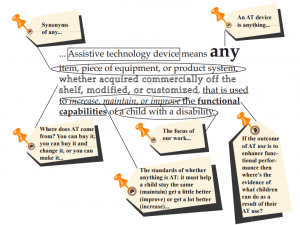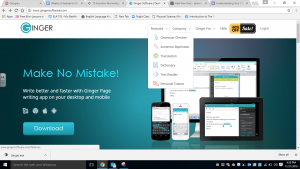I start this week by acknowledging that this topic was the steepest learning curve for me in EC&I 833. I realized as soon as the other group began presenting that I really had no prior knowledge or experiences with assistive technology. As I have mentioned in previous posts, the school I teach in is technologically fairly poor, and I have had little to do with assistive technologies.
The article, Rethinking Assistive Technology by Dave L. Edyburn, Ph.D is a good starting point for understanding the basics of assistive technology, as it begins by defining key terms and ideas that are important. I particularly liked the graphic below, which “dissects” a commonly used definition of an assistive technology device.
There are a few things from this graphic that stands out to me- “An AT device is anything”- this reminded me of a post Launel shared on Google+, in which her husband’s cousin creates tools to allow him to be successful as a machinist. I wouldn’t necessarily had thought of that as assistive technology before. The article also specifies that AT must help a child stay the same, get a little better, or help them to get a lot better. I think this is really important when we consider that AT must serve a purpose, and not just be another educational buzzword. We are far too willing to jump on technology bandwagons without thoroughly considering the purpose.
Looking at assistive technology as a whole was too big a concept to tackle in a single blog post, so I decided to focus my efforts on an AT that was of interest to me. As a middle-years ELA teacher, I was interested in learning more about the AT Ginger, which I first read about on Teach Thought. My goal this week was to learn more about this program, and to see if I could justify recommending it to some of my students and possibly my administration team (the big downside: it is not a free program).
Ginger is an app that has several features that can help students who have difficulty writing (which in my experience is a surprising number). Ginger can help students who have dyslexia, dysgraphia, dyspraxia, and other learning disorders with writing. It is also designed for speakers of languages other than English, which is a huge benefit in a province with increasing numbers of EAL students.
Ginger has 6 main features:
- Grammar checker: this feature doesn’t sound like anything new, but in addition to finding obvious errors, Ginger can also recognize commonly misused words like “there,” “their” or “they’re” and “to”, “two”, “too”.
- Sentence rephraser: this is one of my favorite features, it’s tagline being “express yourself in better ways“, where students can enter their original thoughts and the program will help them tweek it
- Translation: 40 different languages
- Dictionary with contextual definitions and synonyms
- Text reader: text to speech tool
- Personal Trainer: unique to each student, it helps them to learn from their own individual mistakes
After learning more about Ginger, I have decided to speak to a number of my students and parents about the potential of getting it set up on their devices. I can see the potential for enormous benefit in their confidence, and the quality of their written work. The disadvantages I see are the financial cost, and the availability of the technology to run the program.
I am extremely interested to know if anyone has had experience with Ginger- please share!


